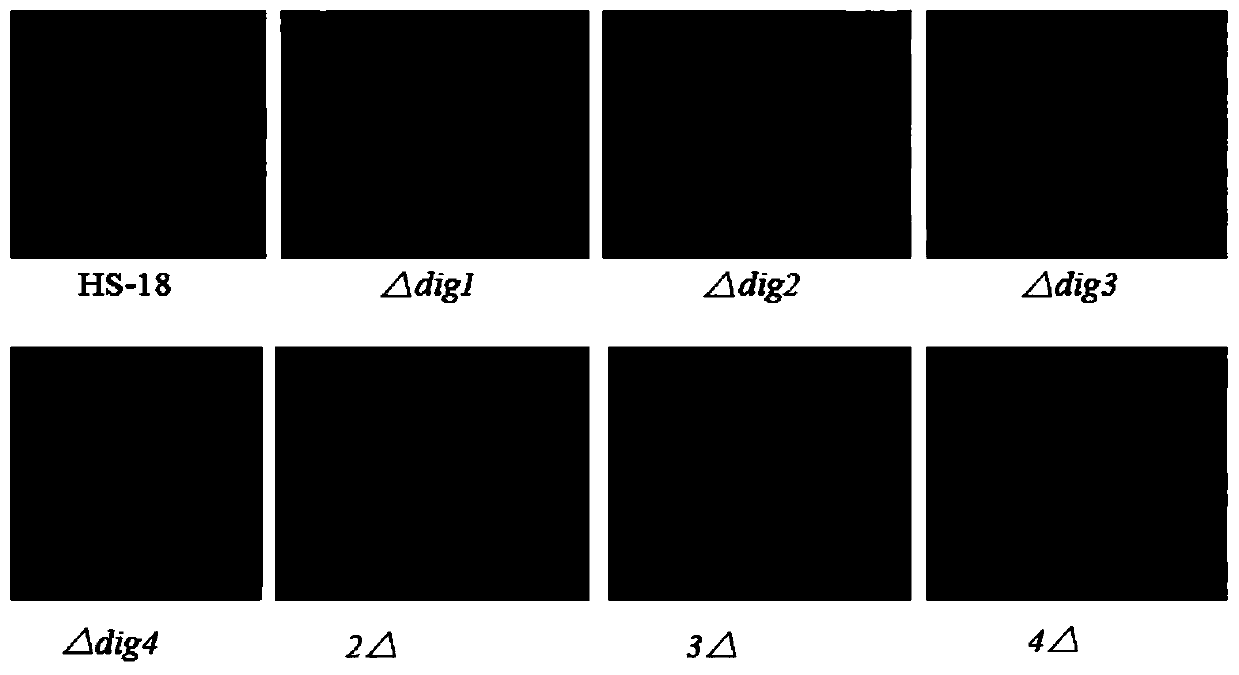Diffusible signal factor (DSF) quorum sensing signal degradation genes and application thereof
A quorum-sensing signal and gene technology, applied in the fields of application, genetic engineering, plant genetic improvement, etc., can solve problems such as economic loss and little research on prevention and control methods, and achieve the effect of improving degradation ability
- Summary
- Abstract
- Description
- Claims
- Application Information
AI Technical Summary
Problems solved by technology
Method used
Image
Examples
Embodiment 1
[0047] Example 1 Acquisition and identification of DSF degradation genes in Pseudomonas nitroreducing strain HS-18
[0048] 1. Experimental materials
[0049] The inventors obtained a high-efficiency DSF-degrading strain Pseudomonas nitroreducing by using DSF as the sole carbon source to separate, purify and identify 16s rDNA from soil samples that have been contaminated with oil for a long time near South China Agricultural University. (Pseudomonas nitroreducens) strain HS-18, this strain HS-18 has been deposited in the China Type Culture Collection on May 12, 2017, and the deposit number is CCTCC NO: M2017257 (see patent 201710764814.6).
[0050] 2. In the present invention, the DSF degradation function of the above-mentioned strain HS-18 is explored and analyzed at the gene level, and DSF degradation related genes dig are obtained through gene analysis and amplification methods, including dig1, dig2, dig3, and dig4. And by designing primers to amplify dig1, dig2, dig3, dig4 seque...
Embodiment 2
[0060] Example 2 Construction of four gene deletion mutants of dig1, dig2, dig3, and dig4 in HS-18
[0061] The pK18 vector was used to construct knockout vectors for the four genes of dig1, dig2, dig3, and dig4, and transformed into DH5α. After PCR verification, the positive transformants were confirmed, namely knockout donor bacteria DH5α (pK18-dig1), DH5α (pK18- dig2), DH5α (pK18-dig3) and DH5α (pK18-dig4). Cultivate the helper strain E.coli HB101 (pRK2013), donor bacteria, and recipient bacteria overnight. Using three-parent binding technology and the principle of homologous recombination, the correct knockout mutations of dig1, dig2, dig3, and dig4 were obtained by PCR body.
Embodiment 3
[0062] Example 3 HS-18 test for the growth of each successfully constructed knockout mutant in the MM* medium with DSF as the sole carbon source and the DSF degradation ability
[0063] After each mutant successfully constructed in Example 2 was activated on the LB solid plate, a single colony was picked and cultured in the LB liquid medium overnight. Use MM* liquid medium to OD 600 Resuspend to uniformity, about 0.5. Inoculate at a ratio of 1:100 into 3ml of MM* medium with 0.5mM DSF as the sole carbon source, and culture at 30℃ and 150rpm in a constant temperature shaker. After culturing for 0h, 3h, 6h, 9h, 12h, 24h After that, use an ultraviolet spectrophotometer (NANODROP) to measure the absorbance value at a wavelength of 600nm to indicate the growth of microorganisms; then add ethyl acetate to the sample for extraction, take the upper organic phase, repeat twice, and combine the extracts. After rotary evaporation to dryness, the volume was adjusted to 200 μl with methanol ...
PUM
 Login to View More
Login to View More Abstract
Description
Claims
Application Information
 Login to View More
Login to View More - R&D
- Intellectual Property
- Life Sciences
- Materials
- Tech Scout
- Unparalleled Data Quality
- Higher Quality Content
- 60% Fewer Hallucinations
Browse by: Latest US Patents, China's latest patents, Technical Efficacy Thesaurus, Application Domain, Technology Topic, Popular Technical Reports.
© 2025 PatSnap. All rights reserved.Legal|Privacy policy|Modern Slavery Act Transparency Statement|Sitemap|About US| Contact US: help@patsnap.com



